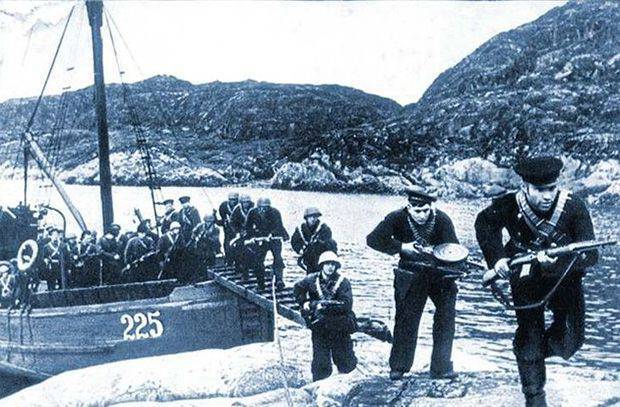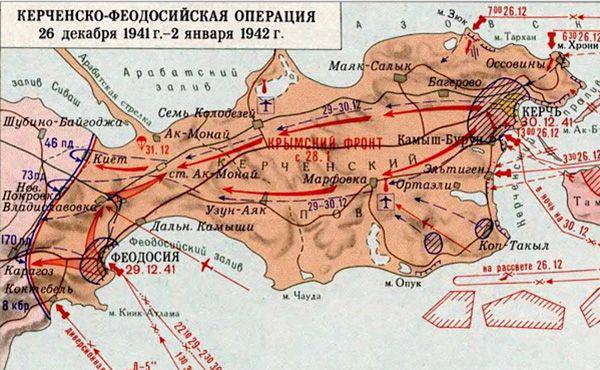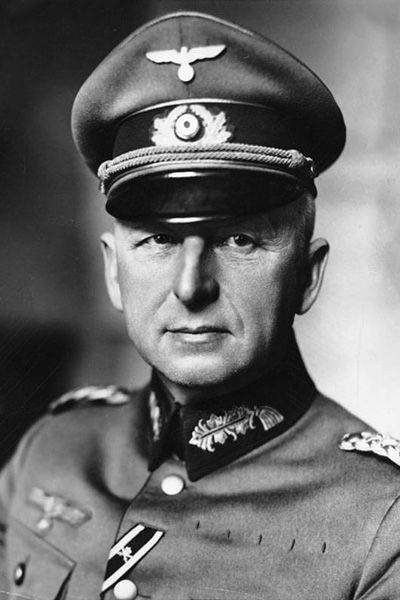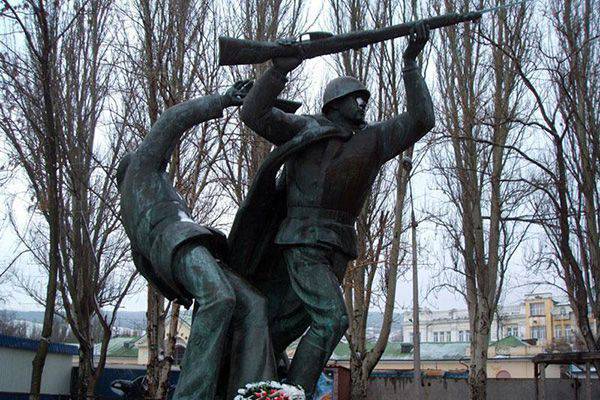The first liberation of Crimea: the history of the Kerch-Feodosiya landing operation

As planned and implemented one of the largest amphibious operations of the Great Patriotic War
We are accustomed to perceive December 1941 as a time marked by the only, but very large, success of the Red Army: the counteroffensive near Moscow. Most of us remember that in the last month of the first, most terrible year of the war, the Red Army released only the Moscow region cities. In fact, not only them: 30 December 1941 of the year Kerch and Theodosius were liberated.
This is the result of one of the largest and most famous amphibious operations in stories World War II: Kerch-Feodosia. And although the return of our troops to the Crimea for the first time was short, the landing force played a huge role. First, he allowed the besieged Sevastopol to repel the second, most brutal assault, and second, he forever discouraged the Wehrmacht’s command to use the Kerch Peninsula as a springboard for an attack on Taman and the North Caucasus.

The enemy put itself under attack
Fascist troops entered the Crimea at the end of September 1941, breaking through the defense of the Perekop Isthmus. In just a month, the Germans managed to take control of the entire peninsula, and only the main base of the Black Sea fleet - Sevastopol - continued to resist. The first assault on the city, which its residents together with the military managed to turn into an almost impregnable fortress, began on October 30 and lasted until November 21, but was not successful. Having withdrawn the battered forward units from the Sevastopol borders, the commander of German troops in Crimea Erich von Manstein began to prepare for a second assault.
To break the resistance of Sevastopol, Manstein pulled almost all the available forces to the city. In fact, the peninsula was not covered by the Germans: it was controlled by a single infantry division, supported by several cavalry, mountain rifle and artillery units. Meanwhile, in Taman, two Soviet armies were in combat readiness — 51-i and 44-i, evacuated from the Crimea, redeployed from Iran, where she participated in a joint Soviet-British operation to neutralize the pro-German government of this country. At the disposal of the Soviet command was the Black Sea Fleet, which actively supported the besieged Sevastopol, and the Azov military flotilla.

In such conditions, the idea of landing a strategic landing on the Kerch Peninsula could not be born. And on November 26, the command of the Transcaucasian Front, led by Lieutenant-General Dmitry Kozlov and where the future Marshal was Chief of Staff, and then Major-General Fyodor Tolbukhin, sent a report to the General Headquarters of the Supreme Command. Two days later, an answer came from the Stavka demanding to state the idea in more detail and accompany it with the calculation of the necessary forces and means. The detailed report went to Moscow on November 30.
At that moment, the Soviet command did not expect significant results. The plan envisaged only mastering the eastern part of the Kerch Peninsula, from where the airborne detachments should have moved on to Theodosia. But even in this form, the plan clearly guaranteed that Manstein would have to withdraw at least part of the forces from the Sevastopol direction. This alone justified the idea of landing. In a “lightweight” form, the plan of the Transcaucasian Front was approved by the Bids directive from 7 in December 1941 of the year, and Taman immediately began preparations.
By skill and number
To guarantee success and really help the Sevastopol people who were preparing to repel the next assault, the command of the Transcaucasian Front tried to achieve a significant advantage in forces. By the beginning of December, it was known for sure that there are about 11 thousand enemy soldiers and officers on the entire Kerch Peninsula. These were parts of the 46th Infantry Division of the 42nd Army Corps of the 11th Army of the Wehrmacht (the army itself was almost completely concentrated in the Sevastopol region), as well as the 8th Romanian Cavalry Brigade and the 4th Mountain Rifle Brigade of the Wehrmacht plus two tank battalion, two field artillery regiments and five anti-aircraft artillery battalions. In addition, the Kerch group of the Germans could count on the support of fighter and bomber aviationbased at the airfields in Simferopol and Saki.
At the disposal of the command of the amphibious operation were much more significant forces. 44-I “Iranian” army under the command of Major-General Alexei Pervushin and shortly before the 51-I army evacuated from the Crimea and hastily replenished 42-I under the command of Lieutenant-General Vladimir Lvov as part of nine rifle divisions and three rifle brigades, and also means of reinforcement: five artillery regiments, motor-assisted and engineer battalions, two long-range air divisions and two air regiments (a total of about 000 400 manpower). In addition, the 398-i and 126-rifle divisions and the 1941-th separate tank battalion, which at the end of December of the 156-th separate units participated in the landing force, were in reserve. The 250 Rifle Division (from the Transcaucasian Front) was allocated to defend the coast of the Azov Sea. The ships of the Black Sea Fleet, commanded by Vice Admiral Fedor Oktyabrsky, and the Azov military flotilla under the command of Rear Admiral Sergei Gorshkov were to deliver troops and equipment to the landing areas. They had over 52 ships and ships at their disposal, including two cruisers, six destroyers, and 161 patrol and torpedo boats. The fleet was supposed to cover the aerials of the Black Sea Fleet, which at that time had XNUMX aircraft.
Second storming of Sevastopol breaks all plans
To prepare, the Stake took 12 days: to give more in the face of increasing pressure on Sevastopol meant to multiply the risk that the Wehrmacht would succeed. In addition, according to the intelligence available to the High Command, the Fuhrer who got rid of himself at Moscow, whose frustration at Rostov-on-Don and Tikhvin reinforced their annoyance, demanded Manstein to take Sevastopol by the end of the year at any cost. And it was clear that the general will try to fulfill the order.
So according to the plan, the training was supposed to end on December 19 of the year 1941, and after two days the first groups of paratroopers were to land on the Kerch coast. But two days before the end of the training, von Manstein suddenly launched an offensive, launching a second assault. This mixed the cards to the Soviet generals. I had to hurry to transfer to Sevastopol the most prepared units that were supposed to participate in the landing, the 345-th rifle division and the 79-th brigade of marines. In order not to bare the troops, these units were replaced by much less experienced mountain riflemen from the Transcaucasus.
All this led to the fact that the beginning of the operation had to be postponed for five days. But, surprisingly, it had no effect on the readiness of the German group on the Kerch Peninsula to organize opposition to the landing force. After the war, it turned out that a few days before the start of the Kerch-Feodosiya operation, von Manstein received information from the defectors about the impending strike. But since the defectors did not know the exact number of forces involved in the operation, and the landing sites could be approximated, the general, who focused on the need to take Sevastopol as soon as possible, did not pay proper attention to this information. In the post-war memoirs, the warlord wrote: at that moment it seemed to him that some more and the besieged city would fall, because Manstein did not intend to disperse the forces to repel the distracting, as he thought, Russian blow.
The decision of the German general, about which nobody knew at Taman at that moment, eventually played into the hands of the Soviet commanders. Late in the evening of December 25, the first ships and ships with paratroopers departed from the moorings on the eastern shore of the Azov Sea. At dawn 26 December, they were already approaching the western coast of the Crimea ...
Throw from Taman to Crimea
In the first wave of the landing, which was heading towards Kerch, marines and units of the 51 Army were marching. There was no reason to expect that they would be able to land directly in the Kerch port: during the battles for the city that ended with its surrender, the ammunition stored at the berths exploded and the port facilities were largely destroyed. Therefore, the paratroopers were heading slightly away from the city: in the area of Kamysh-Burun, Cape Khroni, Cape Zyuk and Cape Opuk.
On the first day, the detachments marched to Kamysh-Burun and to the area of Cape Khroni were most successful. Other groups because of the storm and the constant raids of German aviation (Manstein shifted the responsibility to repel the landing on the pilots) were forced to return to Temryuk. Only two days later, December 28 slightly subsided storm allowed to resume the transfer. It lasted until December 30, and during this time, around 12 000 people were able to transfer to the Kerch area. Alas, they had too little artillery and tanks: for their delivery, amphibious landing craft that had a small draft, on which it was possible only to approach the shores beyond the Kerch port, were ill suited. In addition, many had to jump out in shallow water and reach the shore on the chest in icy water, and even by swimming, which significantly weakened the airborne units.
So instead of the planned offensive and the capture of Kerch, the units deployed in the area of the city were forced to defend the captured bridgeheads. The situation changed on December 29, when the second phase of the operation began - the landing of Theodosia landing force. It began at four in the morning with a short artillery preparation, which so stunned the Germans who defended the port, that they could not organize decent resistance. So rather quickly, the assault detachments, consisting mainly of Black Sea sailors, captured the port, which allowed the second wave of the assault to land no longer under fire or anywhere, but with moored ships and ships directly on land.
However, having lost the port, the Germans managed to organize resistance in the city, so that Theodosius was able to fully take over only by the morning of December 30. On the same day, the units of the Wehrmacht, defending Kerch, in spite of Manstein’s order to stand up to the last, left their positions and moved quickly westward, towards the main forces. If they had not managed to do this, they would have been surrounded: although the Kerch group of Germans was strong enough, after the liberation of Theodosia and the arrival of reinforcements to the landing force, they would have no chance.

Victory, turning into defeat
It would seem that it is necessary to develop success, drive the enemy all the way to Perekop, unblocking besieged Sevastopol! Unfortunately, in December 1941, our army was still learning seriously, not from textbooks, but on the situation to beat the Wehrmacht. And far from always the commanders decided on actions that did not have time to get the approval of the Headquarters or went against its orders. And in relation to the Kerch-Feodosiya operation, they demanded the connection of the advancing armies and the complete liberation of the peninsula.
"If the enemy took advantage of the situation and quickly began to pursue the 46 infantry division from Kerch, and also struck resolutely after the Romanians departing from Theodosia, the situation would be hopeless not only for this newly emerged sector ... - later wrote in his memoirs von Manstein. - The fate of the entire 11 Army would be decided. A more decisive enemy could paralyze the entire supply of the army with a rapid breakthrough on Dzhankoy ... But the enemy could not use the favorable moment. Either the enemy command did not understand its advantages in this situation, or it did not decide to use them immediately ... The enemy clearly saw only his tactical goal - the destruction of our forces on the Kerch Peninsula - and completely lost sight of the operational goal - the intersection of the main vital artery 11- th army.
All this, alas, is absolutely fair. Having liberated Theodosius, the 44 army moved not to the west, behind the retreating enemy, but to the east, to join up with the 51. The Germans took advantage of this mistake, and when the Soviet troops were already preparing for the offensive deep into the Crimea, they launched a counterstrike, on January 18, again seizing Theodosius. True, the Wehrmacht could not build on success, and the loss of the Feodosia port did not become critical for the Crimean front formed on January 28 from the 44 and 51 armies, which were joined in early February by the 47 army commanded by the Iranian border Major General Konstantin Kolganov. Even at the end of February, his troops managed to organize an offensive with the aim of releasing Sevastopol, but failed. Two months later, the German command launched the notorious Operation Hunting for Bustard, which ended on May 18, with the complete defeat of the Crimean Front and the occupation of the entire Crimea.
Despite the fact that the distant finale of the Kerch-Feodosiya operation was unsuccessful, it played an enormous role in the history of the Great Patriotic War. Both the second assault of Sevastopol and the violated plans of the Germans to use Kerch and Theodosia as a springboard for throwing at Taman and the North Caucasus, and several enemy divisions that had been ground were torn off — all this can and should be credited to the soldiers and seamen who participated in the landing party.
- Sergey Antonov
- http://rusplt.ru/wins/pervoe-osvobojdenie-kryima-istoriya-kerchenskofeodosiyskoy-desantnoy-operatsii-20554.html
Information